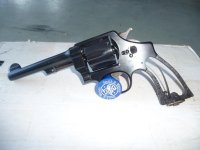Here is one of mine from a relative. It saw a lot of action and was at The Bridge at Remagen as well as other places. The holster is a RIA and actually for a 1911 but the strap was stretched to fit this gun. That is not a scratch on the gun it is a oil smear.
He is wearing it in the picture. Not many pics survived and what did are poor quality.


He is wearing it in the picture. Not many pics survived and what did are poor quality.



